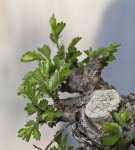The Japanese word “yatsubusa” literally means “eight buds or cluster of buds”. It is used to describe plants which are dwarf in plant character, have multiple buds, often with small foliage, generally easy to root from cuttings and often the ability to maintain growth in the inner shady branches.
Yatsubusa variants have been selected in Japan with
Pinus parviflora, Pinus thunbergii, Pinus densiflora, Picea glehnii, Acer palmatum, Acer buergerianum, Ulmus parvifolia, Zelkova serrata and numerous others used for bonsai training. There are hundreds of yatsubusa cultivars with over 50 of Pinus parviflora alone.
Named variants often use the word yatsubusa, such as Ulmus parvifolia ‘Yatsubusa’ which therefore denotes the cultivar name as simply ‘Yatsubusa’. The Seiju elm, Ulmus parvifolia ‘Seiju’ is in the dwarf or yatsubusa grouping of Elms. It originated as a bud mutation on another yatsubusa elm, Hokkaido elm,
Ulmus parvifolia ‘Hokkaido’. This excellent plant was selected, named and introduced by H. Carl Young of Seiju-en Bonsai Garden in Lodi, California in 1975.
The Yatsubusa Chinese elm,
Ulmus parvifolia ‘Yatsubusa’ is a totally different cultivar from Seiju elm and did not originate as a sport from Seiju elm. Yatsubusa Chinese elm is a considerably older cultivar than the Seiju Chinese elm. Although the bark may seem similar, the Yatsubusa Chinese elm is a bit more finer textured than the Seiju Chinese elm.
When studying plants I usually plant cuttings in the garden to observe their growth habits and often compare them to other cultivars of the same species. I find it interesting to see how large the foliage is naturally and usually use those larger branches for cuttings. The foliage reduces quite quickly when container grown and even smaller when trimmed for bonsai training.
Over 20 years ago I took a cutting from my Yatsubusa Chinese elm and planted it in one of my bonsai display gardens next to the garage. It grew, and grew and grew, now over 20 feet tall with a trunk base of nearly 24 inches. A photo is attached of the entire tree. But I need to mention that I often remove heavy sections of the tree for cuttings and also for demonstrations to show the natural growth. The foliage on the giant garden tree still has the same elongated shape with pronounced leaf margins, only larger.
Both Yatsubusa Chinese elm and the Seiju Chinese elm are superb dwarf cultivars for bonsai training. If I had to make a choice, I’d train Seiju Chinese elm rather than the Yatsubusa Chinese elm. But both are excellent.
Bill














